How to Ensure Accuracy While Searching Non-English Patent Literature – Webinar
How to Ensure Accuracy While Searching Non-English Patent Literature?
Patent offices across the globe receive applications in multiple languages. To search and understand these applications, an analyst who only understands English requires a quick and accurate translation. Machine translations are improving every day and they now understand context-based meanings and rules of grammar. However, it is still difficult to claim that machine translated texts are 100% reliable and provide accurate results.
In this webinar, we will discuss some of the best practices that may help you minimize the chance of missing a patent due to limitations of machine translated text.
Table of Contents
Key-points covered in this webinar (How to Ensure Accuracy While Searching Non-English Patent Literature?) session
- Ensuring accuracy while searching patents using machine translated text.
- How to ensure that your search strategy captures important patents despite limitations of machine translations.
- How to interpret untranslated words while reviewing results and improving your search strategy.
- What are the ways to identify relevant key words in machine translation?
- Key differences between searching Non-English patent literature syntax vs Machine Translated text.
Key-note Speaker
Lakshay Sharma, Senior Patent Analyst, Sagacious IP
Anchor
Tanmay Mittal, IP Head, Sagacious IP
Submit Your Information to watch the Webinar Video:
Webinar Transcript
Tanmay Mittal: Hi, everyone. I can see that many participants are still joining, so I suggest that we begin in just a minute. To utilize this time, let me walk you all through tech checks and the systems. By default, all the listeners are in listen only mode, you can easily find the microphone icon on the control panel which would be in red. Once the speakers finish their talks, you can ask your questions to them. I hope I am audible, and my screen is visible to everyone. For a better experience, we recommend using headphones or earphones. We will begin the webinar in just a moment, so I request everyone to grab their coffees and be ready.
Welcome, everyone, to the webinar. This is Tanmay Mittal, head of IP Solutions, India region at Sagacious signing in from Delhi to welcome you all to our webinar today. In our endeavor, to demystify IP inflammation, and contribute towards boosting IP awareness, Sagacious IP and Trilogy IP are happy to host today’s webinar, which will not only throw light on best practices for searching patents in non-English jurisdictions, but also give us the opportunity to interact with patent experts from English and Chinese languages, and also learn from their experiences.
The topic of our today’s webinar is “How to Ensure Accuracy While Searching patents in non-English Literature”. And before I go on to introduce the esteemed speakers for today’s session, I’m delighted to welcome all the participants from different countries and thank them for taking out the time to join us today.
As I always say, your participation is a wonderful encouragement to the efforts and attempt that we are making to raise awareness about intellectual property through the knowledge that has been honed by Sagaciously, over several years of working with inventors, R&D organizations, IP departments, and IP law practices.
Before I introduce the speakers, let me talk a bit about Trilogy IP, Trilogy IP is an IP consulting firm based out of Shanghai. The company focuses on Chinese, Korean, Japanese patent, and non-patent searches, including product research for infringement cases. Also, I would like to mention that Sagacious IP and Trilogy IP are in a joint venture, and Sagacious IP operates as Trilogy IP in mainland China.
With that, let me introduce our speakers, our first speaker is Mr.Lakshay Sharma. Lakshay holds a bachelor’s degree in Mechanical Engineering and pursued training as a research intern from Elastic Lab, DRDO in heat storage. DRDO is the Defense Research and Development Organization from India.
Lakshay was actively involved in the set up for Sukam, Centre for Solar Energy at Manav Rachna University. Lakshay is also a recipient of Outstanding Achievement Award in the research domain by Dr.Outi Kallioinen, President at Lahti University of Applied Sciences from Finland. Lakshay has expertise in prior art searching, invalidity-validity cases, freedom to operate analysis, and landscape analysis.
Welcome to the webinar Lakshay.
Lakshay Sharma: Thanks,Tanmay
Tanmay: Next I am delighted to introduce Mr.Will Sweetman to the audience now. Will is the Director of Trilogy IP and has about 14 years of experience in patent research. Ever since he’s out from the University, with an MS in Biochemistry, Will has been focused and operating in intellectual property. Will is joining us from Shanghai today.
Will is among literally the first batch of people who devote themselves to the IP domain in China, with a team of friends, equipped with same vision and ambition, is now leading the firm to support customers globally.
Before we start with the presentation today, I invite our listeners to keep sharing their questions as, and when they have it during the course of the session. They can share their questions where the GoToWebinar question box on the right side of this presentation window. I will pick up on those questions and ask them to our speakers after they finish their brief talks.
Also, Sagacious IP is offering a free consultation to all of the webinar attendees for planning their IP strategy in India, China, Korea, and Japan.
Let us now get started with the main part of the presentation, and for that let me try and set up the context of this session first. Prior to this webinar, we created a poll on LinkedIn, and we tried to understand how people think about machine translations.
LinkedIn polls for Machine Translation
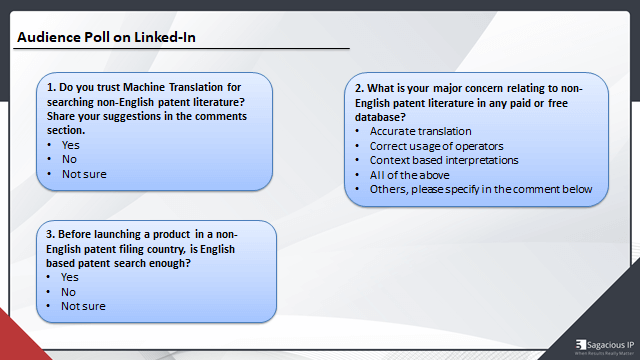
So, some of the questions that we asked on LinkedIn are: Do you trust machine language for searching non-English patent literature? What is your major concern related relating to non-English patent literature in any paid or free databases? Before launching a product in a non-English patent filing country is English based patent search enough?
Results of polls
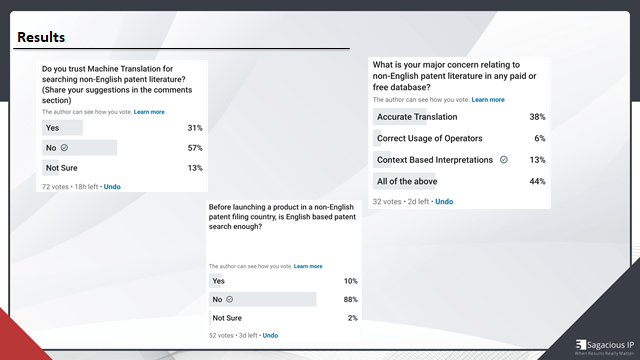
Let me show you the results, 57% of the people said that they don’t trust machine translation for searching non-English patent literature background. Around 44% of the people voted that they believe in going for accurate translation, correct usage of operators and context based interpretations as the top concerns related to non-English patent literature in any paid or free databases. And then around 88% negated the fact that before launching a product in non-English patent filing country, only English weighed patent search would be enough. So, 88% think that no, it’s not enough and we need to do a search in that specific language.
A case study about magic of Machine translation
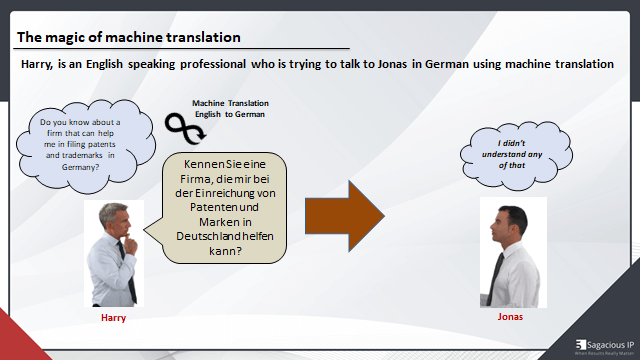
Let me also show you a quick case study and talk a little bit about the magic of machine translation. So, we have Harry, who is an English speaking professional, and he’s trying to talk to Jonas, who does not understand English, but he’s fluent in German.
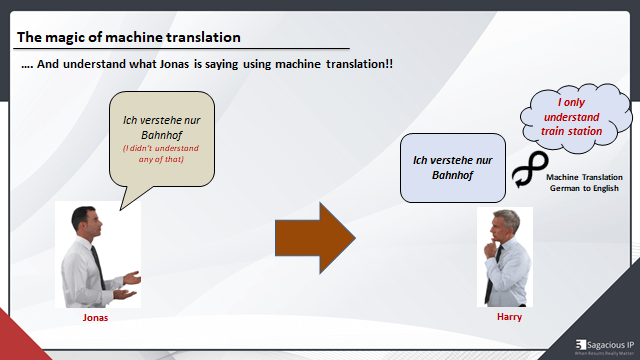
So, Harry wants to understand if Jonas can help him in filing patents and trademarks in Germany. However, Harry doesn’t know German so, he does a machine translations and whatever text he gets, he asks that to Jonas. However, Jonas does not understand anything, and he tries to tell that to Harry that, hey, I didn’t understand anything. But he knows that Harry does not understand German, so he again does the machine translation and asks the question. Harry translates that machine translation into English and he understands that Jonas is saying that he understands only the train station. So, this is a very common use case or a very common scenario that I wanted to highlight before I go ahead with this presentation. I hope with this, our listeners would understand that machine translations can be tricky at times and misleading.
Disclaimer
So, some of the disclaimers we actually have over here is:
- When we are creating this webinar, we want you to keep one language as a reference language. So, no disrespect to any of the language. We have kept English as a first language for this study. The other languages that would be referred to in this webinar will be referred as foreign, native or non-English languages.
- The translations that we show in various case studies over here, these translations are done through online sources and machine translations.
- Data shown in this webinar is mostly collected from Official Patent Office websites, Patent databases, and Worldwide Web.
- The references numbers and the counts that will be shown today are based on patent search that we did on 2nd of September.
- Also, through this webinar and study, we do not want to endorse or defame any of the National Patent Offices, Translation databases or the tools that would be discussed in the webinar. Sagacious IP also does not own any of the logos, cut-outs or trademarks or images that we show here. These are just for illustration purposes, and we disown any claims.
I believe, has Lakshay joined us now. I will be happy to navigate the slides for you if you can hear us and please go ahead with the presentation.
Lakshay: Yes, I can hear you, but I can see disclaimer part.
Facts from Patenting World
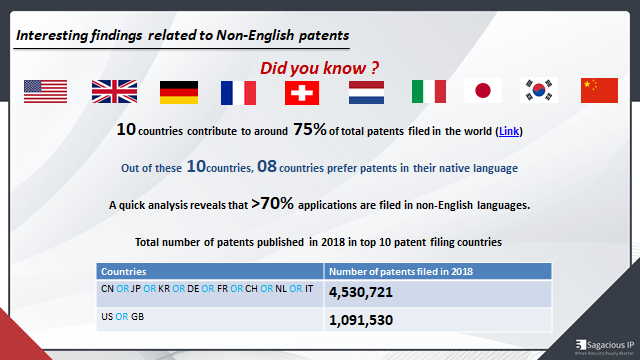
So, let’s see some facts from patenting world now. You would be amazed to know that out of 195 patent filing countries, the top 10 countries contribute around 75% of total patents filed in the world. So that’s a huge part. When we categorize these 10 countries into the two countries which you can see that in the table below, the first row is showing 8 countries and the second row is showing 2 countries.
The first 4 countries are those which receive patent applications in non-English filing language Whereas, the second row, which includes US as well as Great Britain, these are those countries which receive patent application in English language.
So, if we see the number of patents filed in 2018, so we can see that around 4.5 million patents were filed by these non-English patent filing countries and 1.091 million patents are filed by English filing patent countries.
So, you can see that more than 70% patents out of these 10 countries are being filed in non-English language. So, what does it indicate? It indicates that in 2018, so we had a huge volume of non-English filing patents. It was all about the data of 2018.
Publication trend in 10 countries
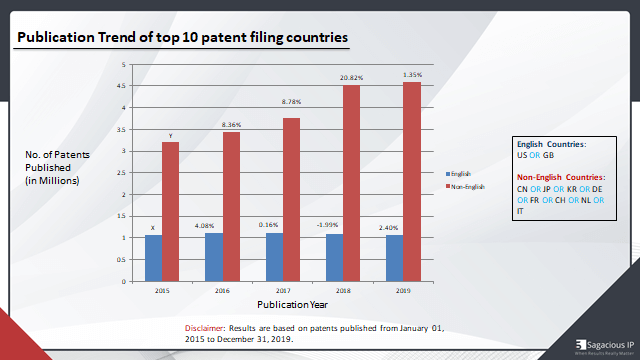
Now, let me show you, what is the publication trend of these 10 countries in the last five years. You can see the graph here, where the x-axis is representing the publication year and the y-axis is representing number of patents published in millions.
You can see the 2 bars. The blue bars are showing the patents published in English filing countries like US and Great Britain. Whereas the red bars are showing patents published in non-English patent filing countries which I already shared in previous slide also China, Japan, etc. So, these are 8 countries.
Now, let me take you over to the blue bar graph. If we say that there are x number of patents filed in 2015. So, in 2016, you can see there is an increase of 4.08%. Whereas in 2017, there’s a little bit slower increase that is 0.16%, and this bar decreases to 1.99%, so there’s a decline here in 2018.
However, there is a small increase, but there is increase of 2.4% in 2019. So, indicates that patent publication trend is quite constant in non-English filing country, US and Great Britain. Whereas if we move forward to the publication trend of non-English filing countries like there is red bar graph. So, we can see that in 2015, if there were y number of patents published between 3 to 3.5 million, so in 2016 there was an increase of 8.36%. It is a great increase. Whereas in 2017 also there was an increase of 8.78%. However, the graph rotates to 20.82% in 2018. So, it’s a huge increase. And in 2019 also it’s a small increase but still there’s an increase of 1.35%.
So, it indicates that the publication trend in the last five years in non-English filing countries is increasing and simultaneously, the need of machine translation is also increasing.
So, what is the challenge? So, we are seeing here that how big the challenges? As we move forward to the next slide, in which we’re talking about it, what does it mean as far as business side is concerned.
Challenges in filing patents in some countries
So, suppose that if a company wants to launch a product to top 10 economies, where are the top 10 economies as per data of 2019 are US, China, Japan, Germany, UK, India, France, Italy, Brazil, Canada. And you can see the red colored countries, that is, China, Japan, Germany, France, Italy. So, these are those countries that are receiving patent applications in non-English language or their regional language.
So, probably the company will try for an FTO search. And suppose that the analyst is doing an FTO search and there was an error due to interpretation, like Tanmay had shown an example of Harry and another German person Jonas. Similarly, if there is an interpretation due to machine translation error, so we might miss a relevant patent due limited skills or knowledge we have to present it. And what would it lead to? It may lead to an infringement of patent. And ultimately, there can be a huge loss to the company. So, this slide is showing that how big the problem is.
Steps followed in the webinar
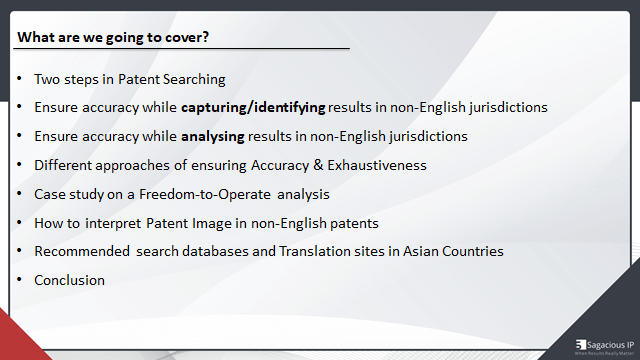
We will find out some concrete solutions, which we can add up in our daily life while we are doing patent searching, or if we want to get patent search, FTO search or anything else.
So, what steps we can follow. We will learn here, and we will also have our foreign language expert, Well. So, it would be a great session. So, let me go through the steps that we are going to cover in the next slide.
So, the first one would be the steps which we usually adopt is patent searching. And the next would be how to ensure accuracy while capturing or identifying results in non-English jurisdiction. And the third would be how to ensure the accuracy while analysing the results. Means in the next slide, it would be about how to capture and the next will be how to analyse the result. And after that, based on the previous slides, we would have different approaches of ensuring accuracy and exhaustiveness. After that, we will get a live demonstration of different approaches to a case study on freedom to operate analysis.
And after that, we would like to learn about how to claim the patent image in non-English patents. And it would be an interesting slide because usually, we get lots of patents, or which are in non-English language. So, after that we would have recommended search databases and Translation sites and countries that were recommended by our foreign language expert. And after that, we will see conclusion.
And now, without wasting time, let’s move forward through the steps in patent searching.
Steps in patent searching
Prepare key features
So, when we get a task for patent searching. So, first of all we prepare key features for the search and accordingly we prepare search focus. And then we prepare keywords, find the classifications, prepare search strategy and then we run the search strategy on our databases to get a set of patents that we will have to analyse with respect to key features.
Analyse the patents
So, now we get a set of data and then, our next step will be to analyse these patents.
So, these two things, means capturing the patents and analysing the patents should be balanced. For example, if we miss, we fail to capture any important result due to any reason, so the patent searching will be imbalance and similarly, if we get the patent but we fail to interpret it correctly, then also it’s an imbalance. So, how to balance patent searching with respect to translation, we will learn in the next slides.
A case study
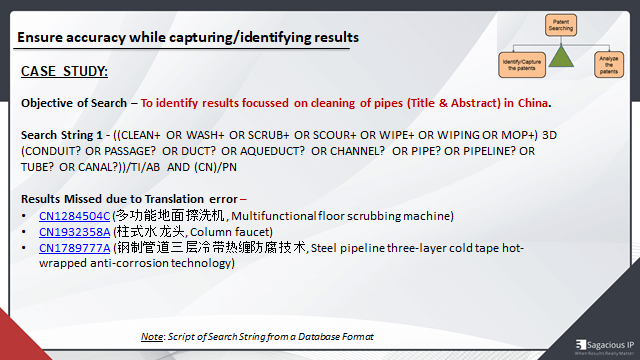
We have a case study here, and in this case study, our objective was to identify results that disclose about cleaning of pipes in title and abstract in China.
So, for that, we have prepared a search string based on English keywords and based on some operators, based on database. But when we rectified it, we found that we missed these Chinese patents which you can see on your screen. So, these 3 patents were missed and we found them due to translation error because they were not disclosing in our databases that cleaning of pipes. So, machine translation was showing in some patents in 1st or 3rd patents like cleaning of pipes was disclosed. But these 3 patents were missed and as English language what strategies we can adopt so we will learn few points in the next slide.
Suggestions
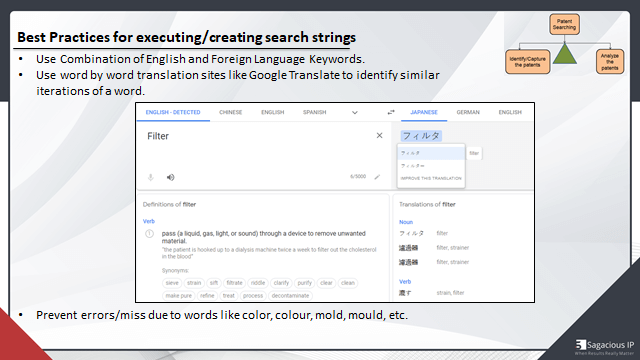
So, our first suggestion would be we can use the combination of English as well as foreign language keyword. Just for an example, foreign language in this case was China, because we had to find patent in China, maybe for FTO study or other studies. So, we can use here a combination, but how to use a combination we don’t know the foreign language keyword.
So, for that case we can use some translation sites, for example, Google Translation can also work better. And I had also shown here filter, so we have to find similar kinds of filter in Japanese language.
Usually Google translate gives different options while you’re finding the meaning of a word in different language. So, in that case, it’s necessary that you have to find out the correct meaning. Google will give you the right meaning when you get to that part, whose meaning you have to find out. You have to find out which meaning is suitable for your search. So, in this way, you can use the combination of English, as well as foreign language keyword.
And the third point is, prevent errors/miss due to words like color, colour, mold and mould.
So, in US, people follow color and in Britain, people follow colour. So, they both are correct in their own regions. However, it may pose a problem when we are searching for patents. So, in these types of cases, we should include these types of errors as much as we can.
Now, going forward, so, we have learned that we can use the combination of English as well as foreign language keyboards. So, in next slide we will learn that we have search string tool. In search string tool, what we have used is, we have combined keywords of English, as well as foreign language keyword, as we have learnt in previous slide and we have found that these 3 results were there.
So, now, I would like to ask, Will, because I have used here Chinese language keywords. But I don’t know whether these keywords are right or wrong because I just copied it from the Google Translate or other machine translation sites.
But I don’t know this language, so I can’t say that it is totally correct. We usually don’t use operators like question mark or plus operator. So, would it be better to use operator or better or not? So, I will pass on the baton to Will here. So, over to you Will.
Will Sweetman: OK, this is hello from China.
Tanmay: So, just to set up the context, actually Lakshay talked about what are the best practices while we do searching and we took a quick insight on forming such strategies, wherein we were either using only English keywords, or using a combination of English plus native language keywords to perform a search.
Will: Ya, I got that part and thanks Lakshay.
A Case Study on search string
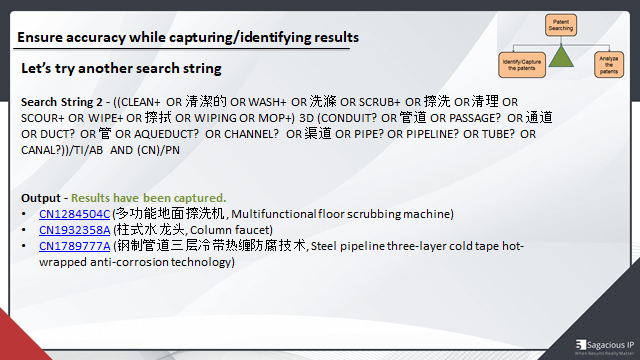
OK, so I’m going to share some of my knowledge, or experience in non-English language patents. So, let’s just to go a little bit back to the very beginning of this case study.
From this case study, you can see this search string that includes a long list of English keywords. And which was made to capture some of the Chinese patents about some cleaning of pipes and to find these English keywords with some of the sites due to translation error. And we have already listed all of those 3 missing results with the patent number and title both in English and Chinese.
Well, I think this is a very good example of how English search string may miss something and how English machine translation will mislead us to something else. For example, the first patent in the example, which is CN1284504C. The title is multifunctional floor scrubbing machine.
If we check the title abstract, or even claims of this particular patent, or to see that this patent is not about anything close to cleaning of pipes. It’s just something for cleaning machine, nothing about cleaning the pipes. So this, probably, due to some misleading translation of the Chinese materials into English, we believe that this could be a missing result from the English search stream, but actually, it should be a noise of the search.
And to give you another example of how bad the machine translation is. Let’s move to the machine translation title of last Chinese patent CN1789777A. Machine translation of this title clears, steel pipeline three-layered cold tape hot-wrapped anti-corrosion technology.
Well, this is a pretty long title and sort of misleading. So, based on the Chinese title, I think the title should be something like “Hot winding anti-corruption technology for steel pipe using a three layer coat”. So, we can see that machine translation to these non-English patents is not satisfactory enough.
Well, as an expert, seeing these non-English researching and analysis, I can say that the machine translation of title and abstract of Chinese or Japanese or Korean patents is relatively good. In most cases, they are understandable based on the machine translation of the titles and abstracts of these Boeing’s patents we could get a near, proper and a standing of these patents. Now, having said that, you can still find these examples where the machine translation of the title is not that good enough.
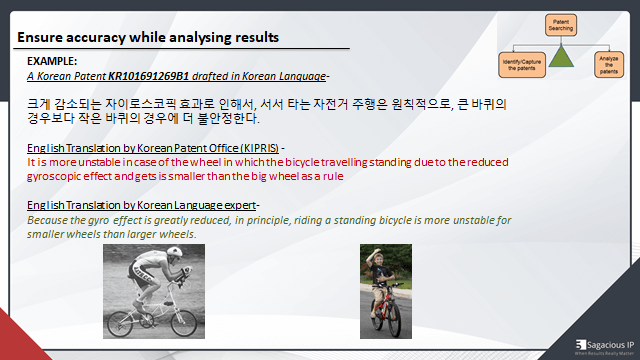
If we move to the next slide, we can find a proper or secured translation. Again, there will be something more complex. For example, let’s use the example which is shown in this slide. From this figure in the slide, we’ll just see a Google translation interface, where English keyword is translated into a Japanese keyword.
If we look little bit deeper into the translations, which are going to Japanese translations. We can see that on the top right part of this screen, there are several rows. There are two options or two possibilities for this Japanese translation of photo. This particular translation in Japanese is actually one font or one type of Japanese. This type is called Katakana.
And if we move downwards to the right bottom corner of this screen, you can see some more options of the Japanese translation of the keyword ‘filter’. We can see some very different characters over there, as compared to the Japanese translation shown above. But I can tell you that they are also the Japanese translation of the keyword filter. They are just another form of Japanese, which is called Kanji. It is basic Chinese or derived version of Chinese into Japanese.
If we move to the lowest part, the bright lowest part, there is a small further option of this translation, if one below the little blue word, you see that? Yes, that’s a verb translation filter, and if you can tell the slight difference in this particular Japanese translation. Yes, this is also another form of Japanese translation. This form is called Hiragana. This is also another form of Japanese.
So, if we are trying to get a proper translation of the English keyword, say to Japanese. Probably there are three forms of this particular English keyword, the Katakana, Hiragana and Kanji they are all possible.
So, if you are trying to compose a search string which combines English keyword and some non-English keywords. We are trying to get a better comprehensiveness in the translations of these English keywords. You’re going to use some of the very good translation tool like Google Translation or some of other trusted tools. You may have to capture all different forms of these non-English characters.
If this isn’t Japanese then there could be three forms of different characters and you need to get all of them to make a better comprehensiveness in search string. We are not even talking about the search itself, it’s just in the step of composing suitable or good search string. You got to do lot of work in this composing step.
So, we can see that the machine translation of this non-English patent or non-English keywords is not that good always. There are a lots of work to do before you get a proper translation of any English keyword.
Example of combine search string of English and Chinese keywords
If we move to the next slide in which my colleague has prepared an example of a combined search string of English keywords and of Chinese keywords. From that search string we captured all three missing results, this is good. But again, this combine search string may not be good enough.
If we take a closer look at this combined search string, we can see some of the Chinese keywords use. But from an expert of naive assertion perspective, we can see that in that search string some of the traditional Chinese keywords are used together with some of the simplified Chinese keyword. Usually they are not used together because the traditional Chinese keywords are maiming for the Taiwanese patent. They cannot capture the Chinese patent in China and vice versa.
So, from this very example, we can see that machine translation is not good enough. And there could be a lot of work to do in the composed need of a super search string to capture the desired. knowing this patent, So, please remind me again Lakshay, what’s your question?
Recommendation on using kind of operators with foreign language keyword
Lakshay: Yes. So, first of all, it is a great insight that you have shown. My second question is that we usually use operators that you can see in cleaning, we have used Clean+ operator. So that it can capture, cleanable, cleaning, etcetera. So, do you use operators like that or do you recommend us that we should do such kind of operators with foreign language keywords? Over to you, Will.
Will: That’s, in fact, a very good question. From this refine search string tool, you can see we used a lot of wildcards and operators in the search string. And the good news is nowadays, lots of these database and even the Japanese and Korean database support every source of wildcards and operators just to make sure searching non-English patent literature as accurate and efficient as possible.
So, yes, to answer your question. We can use the wildcards and operators in the non-English search. Sometimes or in some of the databases we can even use some of the advance forms of operators. For example, an operator to capture some of the key words within the same sentence or within the same paragraph or even some of the operators support a search to capture patents, specifying a specific range of numbers.
So, yes, now we have some of the very advanced wildcards or operators which can be leveraged in non-English searching. However, from my personal experience and also a suggestion to colleagues in English speaking countries, you need to be very careful in using these wildcards or operators in searching non-English patent literature. It’s because meaning of the different combinations of the non-English keywords by those operators or wildcards may change a lot. This in turn will change the scope of the search quite drastically.
So, if you are not a master of a non-English language, you need to be very, very careful before you use any of those about cards, or operators in searching non-English patent literature because sometimes, it may mislead you to nowhere or just to bring in too many noise.
Lakshay, I hope that answered the question.
Lakshay: Yes, you answered so many things which we don’t know. Like you told us different types of languages within Japanese, within Chinese and their operators. They can be used but if you are expert in that. So, it is really a great insight. And as far as analysis is essential, for example, if we have captured the results using the suggestions from you.
Strategy to analyse the patent
Now next comes the analysis part. So, analysis part also becomes difficult sometimes, like you had, the Chinese patent CN777A, so, it is quite misleading. So, in that case, what should be our approach usually we cross-check it from different databases like we are using paid databases. So, we cross-check it from National Patent Offices but sometimes the translation is difficult in National Patent site also. So, in that case, what should we do? What should be our strategy to analyse the patent especially when we are doing critical projects like FTO projects. So, their interpretation of the patent is must and good interpretation is must. So, in that case, what is your suggestion?
Will: So, ok, let’s quickly jump to the conclusion here, for this particular section. After we finish the search part after we capture good amount of patents and we start our analysis step for those non-English patent. We actually have to rely on machine translation. In most cases we cannot arrange manual translation due to constrain in time and budget.
So, in most cases, we need to have proper or accurate understanding to those non-English patents based on the machine translation. So, my suggestion would be, if possible, we should compare machine translations from multiple tools. For example, I suggest that we check the machine translation, and we check the machine translation, Espacenet and, if possible, again, we can also take a look at the machine translation from Patentscope, this is from WIPO.
From our experience, the quality is very, very general quality of these different machine translations of patents. Google translation, Espacenet translation and tedesco transition will be among tier one translation options you choose.
So, you need to compare or you need reference to all 3 machine translations. You go find some of the difference in these machine translations, and in lots of cases, you can get a more accurate understanding of the non-English patents based on comprehensive checking of all the three translation tools.
Hope, this answers to you.
Different approaches for ensuring accuracy and effectiveness
Lakshay: Alright, Yeah. Yes, definitely. So, if we conclude about the previous slides, what we have learned in the previous slide. So, we can go for different approaches for ensuring accuracy and exhaustiveness as far as criticality of project is concerned.
Using English keywords
So you can see, the bottom one is the first approach, in which an English language expert uses English keywords to identify the results. And the analysis is also being done by English language expert. So, it is the first case, and first approach.
Using English and native language
And if we move ahead to the second approach, it uses English, as well as native language keywords, like what Will had said about how we can use keywords and using his suggestions about how to combine English as well as native language keywords. So, it will be done by our English language expert and analysis will also be done by also English language experts. So, here the utilization of only one resource is there.
Using English and foreign languages
So, if we move to the further step, that is, third approach. So, here you can see the 2 resources. It can be one resource also if the person is fluent in English as well as foreign language. For example, Will is fluent in English, as well as foreign languages like China, Japan, Korea. So, this approach can be performed Will. However, if the person is not fluent in other languages, so in this case, you have to use two types of results. One, if the person is fluent in English, the other if the person is fluent in foreign language. So, they both will identify the result set and the analysis will still be done by English language expert.
Two persons for analysis and identification
Now, if we move to another approach that is more exhaustive. So, in this case, it is represented that 2 persons are doing analysis, as well as identification of the result. So, here again, one person can do both the things if he is good in both English and foreign language.
So, these are different types of approaches which we can follow as far as criticality of project is concerned.
How to use different approaches
Now, if we move ahead. So, we will demonstrate quickly that how we can use this approach. So, suppose that we have a case study on FTO Project. As you can see that a company wants to launch a wiping device in China and the wiping devices uses stored water in a tube, which is used for cleaning the surfaces.
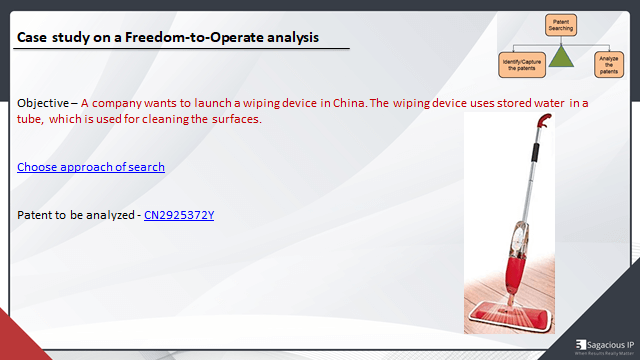
So, for that, let me choose that approach. So here, we have different approaches. For example, if I choose the third approach in which English, as well as foreign language expert is used. For example, me and Will both are analysing the results, so, we both have captured this Chinese result. Now, its analysis will be done by me. For example, if I analyse this patent that we move forward.
So, we have two translations. One is translation from patent databases and another is machine translation. It may be Google or other machine translation. So, if I read through it, a multi section rod body water passing wipers comprising a wiping head (1). And in below line also, there is erase head (1). So, within these three lines you can see that one has been represented by wiping head as well as erase head. Though, both have same meaning.
However, while doing FTO search, there can be any difference. From legal point of it may have an error. So, if I can read the circle portion. So, it is very difficult to interpret how the whole 3 which you can see in the figure, the whole of the pipe, which is connected from the top tube to the bottom tube. So, how it is being connected?
So, it is very difficult to conclude based on the certain part. And if I see that machine translation part, the red color part, the pipe is connected by the pipe body connecting member (4), the water pipe (3) is a slender hose set in multiple sections. The rod body (2) is in a hollow tube (21). So, it is saying that rod body (2) is an evolutionary of rod body (21). However, from the image, it is not looking like that.
So, for that, I would like to switch to that approach to the top in which I would like to call my colleague, Will. So that he can analyse it, because it is difficult for me to interpret and I can’t takd chance for this particular project. So, over to you, Will.
Will: Yes, I agree with you, Lakshay. I’m not sure which database you used. The translation is just not readable, and machine translation is also misleading. But if we use the translation tool ‘Espacenet’ which is in the next slide, I guess. Right, if we check the Espacenet translates it will be much better. A multi-section rod body water-passing glass wiper, comprising a wiping head, a multi-section rod body and a water-passing pipe and is characterised in that: the wiping head includes. All right here, a very tiny in the machine translation, they always use the term includes, but actually, I think, the correct translation should be comprises wiping head connecting pipe.
The main body layer of the wiping head, the wiping material layer and the rubber cleaning strip, the multi-section rod body is a multi-section hollow tube relying on the tube body connecting member connection. Ok, again as we see that Espacenet translation is good enough, I mean general speaking.
But here again, we can see some of the misleading or not so easy to understand part of the Espacenet translation. This particular cost would be multi-section hollow tube (1) is connected by the two body connecting member (4).
So, the term ‘relying’, the era of this is gone. Water-pipe (3) is a slender hose is fine. So, in the hollow tube (21) of the multi-section rod body (2), the rest part is fine.
So, from this Espacenet translation we still have a little bit misleading translation from the machine translation which could be critical in a high stakes search like in FTO.
Translation of non-English images
Lakshay: So, understood Will. So, this example has really shown us how we can use different approaches. Now, if we move to the image part. So, there are lots of images, which are in non-English language. So, Will what is your opinion? We usually use different apps to translate non-English language to English, as far as image is concerned. But, in most of the cases, it is accurate as well. But what is your opinion in this regard?
Will: To our experience as most of the non-English terms in image are very short forms of technical terms and those machine translations or whatever terms machine translation tools used. In most cases those machine translation to this short, technical terms are accurate enough. So, in most cases, we feel comfortable with those machine translations in image if those technical terms are quite short. You may have some problem or issue in understanding a longer sentence or even longer technical terms which is more often in a flowchart, in an image on method.
So, except for those flow charts, the rest part is fine. The rest part of the machine translation, the short forms of those technical terms are generally good enough.
Lakshay: Right. I agree with you because these are basically word to word translation base. And, in most cases, translation base are correct. And if we move to next slide in which we will learn about some of the database. Because, in the previous slides we have learnt that how to the result how to analyse the results based on different machine translation, how to use keywords and about different approaches which we can follow as far as criticality of project is concerned and image translation also. But when it comes to databases, would you like to recommend some of the databases as far as China, Japan, and Korea because these are the countries that have very difficult language. So, would you like to recommend some of the databases?
A poll for the audience: Preference for searching patents in non-English jurisdictions
Tanmay: Before we go ahead, I was just curious to know what kind of approaches our audience generally take while they mine non-English patent. So for that, I was willing to just quickly launch a poll to the audience. And the question is that, which approach do they prefer to take while searching patents in non-English jurisdictions? So, do they generally perform search using only machine translation, or do they perform search using non-English synonyms, or do they often go for foreign language expert or to a firm to go ahead and do that search. So, I’ll just leave this poll open for another few seconds. And then I think this would be a good takeaway for our listeners today from you Will, about what databases you recommend. So far, I got the votes that almost everybody says that they would prefer performing search using non-English synonyms. We have a little bit of votes on people going for automated translations or machine translations to refine their search strategy. Another few seconds for this poll, and then we’ll want to know your opinion.
So I’ll close the poll now, and 75% of us voted for performing searches using non-English synonyms, which is a good number. So, over to you now, Will, and if you can throw light on, what are the recommended search databases and translation sites at least for Asian countries.
So over to you, Will.
Study of some non-English patent databases
Will: OK, it’s very astonishing. And it’s very good for me to know that lots of the audience has chosen to use non-English synonyms. That’s very good. So, I’m gonna use some of these non-English databases. We have a list of some of the non-English database for China, Korea, and Japan here.
Some of them are official search tools developed by the national offices, let’s say. Some of them are the commercial one, paid ones.
For China
So, let’s take a very quick look for China
First one are of Search.cnipr and next is Pss.system are two official ones. I believe them, they also have English interfaces. So the user can still input some English keywords into these two systems and run very basic search using it. If you can use non-English keywords, like Chinese into this, such tools they will give you some very accurate outputs.
And, I want to highlight these 2 for China, Patentics and Himmpat. These two, they support the concept search, especially in Chinese. So, you can even input a long sentence or even a paragraph in English describing the target that you want to search and this system can give you a long list of Chinese patent and the ranking the most relevant ones at the top.
So, basically, they are the concept of search tool, which could be very useful if you want to get the most relevant results. Either from an English search string or even English paragraph. But, again, these two are paid databases, I hope they don’t charge much for this.
For Korea
If we move to the right side for Korea, ‘KIPRIS’ is the official search website. And the second one ‘Global wipscorp’ is a very big database provider. And the WIPS database is pretty good in native Korean language searching.
For Japan.
For Japan, the first one is ‘Jplatpat’is our official website, which is still very good. In either English search into patents or the original Japanese native language search.In the rest 2, ‘Ultra-patent’ or ‘ATMS’, they are two commercial ones. Ultra patent is not that expensive. But ATMS is rather more chance expensive one developed by Fijitsu. But again, it’s very popular in Japan and they support every kind of native language Japanese search. And these are all patent databases.
Non-patent database providers
If we move to the next slide, we have listed some of the non-patent databases for China, Japan, and Korea. Most of them are the mainstream non-patent databases. They can be used for non-English search for the non-patent literatures in all these three countries and most of them are commercialize.
Tanmay: So, I was acknowledging the good insights that we got from Will. And I just wanted to tell our audience that we are on the concluding slide now. And for that I would want to quickly give the takeaways to all our listeners today.
Conclusion
Lakshay: So, let me walk through the conclusion part quickly.
- We have seen that national databases translation may have errors. So, for that purpose, we can cross-check. If we fail to analyse it further by cross-checking, so we can consult our foreign languages expert.
- The second is to capture and analyse results, choose the level of search like accuracy and exhaustiveness. Like we have seen in our FTO case study. So, we have to choose the best approach so that we can do justice to criticality of the project.
- The third one is analysing part. So, as Will, has already said that you should always cross-check at least two translation sites. We have seen that Espacenet was giving better translation. But still, we have to cross-check unless we get into the conclusion of the interpretation. So, we can do brainstorming also within output.
- As far as image translations are concerned. So, these are basically word-for-word base, translation sites, in most of the cases, they perform very well. So, we can prefer image translation sites to translate non-English to English versions.
- And as far as native translation, native patent and non-patent search databases are concerned. So, Will has already told the list of very good databases. So, we didn’t know about these databases. We have performed search on few databases, which Will taught us, some databases will be helpful for us in future.
So, this was a really great insight.
So, this is it for the conclusion part, and I hope that it is insightful for all of our listeners. So, thank you so much for listening. Over to you, Tanmay.
Questions and Answers
Tanmay: Thank you. This was indeed an insightful session, and I just wanted to quickly invite any questions that our audience may have after today’s session. So, quick, one minute or two minutes for any questions that our audience may have.
Which approach is recommended for searching patents in Singapore?
Lakshay: As far as my experience is concerned. So, we can use approaches which we have already learned in the previous slide. So, we can combine the keywords and we can go for the national databases also for Singapore.
Tanmay: I guess, for Singapore, its official language is English. So, I don’t think it would be a challenge searching there because the official language over there is English.
Great. I don’t think we have any more questions for us now and with that, I guess we can end this webinar. And, I want to say that it has been a wonderful session and I want to thank all our listeners. I’m sure our listeners must have had some good takeaways from this session and would be able to utilize these pointers while they are working on their projects and doing searches.
Also, as I disclosed earlier, Sagacious IP and Trilogy IP are offering a free consultation to this webinar attendees’ for planning their IP strategy in India, China, Korea, Japan, and other Asian countries. Also, a quick update, our next webinar will be on “How to effectively capture design patents, or how to do searching in design patents”. So, please stay tuned and register for that webinar.
Again, I want to extend a big thank you to all our listeners who have to start on time and stayed with us till the end. We highly appreciate that and we thank you very much.
Thank you everyone. Closing this webinar now.




